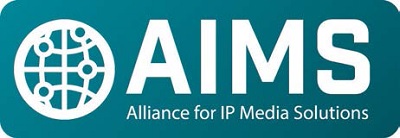‘AIM'-ing for Interoperability
NEW YORK—The broadcast industry was built on standards, but in recent years that has changed due in part to the acceleration in digital technologies. Many vendors have opted to not wait for standards to be developed, resulting in incompatible technologies that require a workaround.

These concerns have led a group of broadcast and media industry suppliers, including Grass Valley, Imagine Communications, Lawo, Snell Advanced Media and Nevion to form the Alliance for IP Media Solutions. The new, independent trade association was founded to foster the adoption of industry standards that would help facilitate the broadcast and media industry’s transition from SDI to IP. The group’s efforts will be focused on promoting the adoption, standardization, development and refinement of open protocols for media over IP, with an initial emphasis on VSF TR-03 and TR-04, SMPTE 2022- 6 and AES67.
PROMOTE, NOT DEVELOP
As part of AIMS’ main charter, the coalition will promote an open standard in the marketplace for the interoperable exchange of uncompressed audio, video and ancillary data streams over an IP network infrastructure. However, AIMS is not in itself a new standards body, but rather a trade association that would work closely with the Video Services Forum (VSF), a 17-year old international association comprised of 74 service providers, users and manufacturers focused on interoperability, quality metrics and education for video networking technologies. VSF led the effort to develop the recently approved TR-3 video over IP standard (see “New Standard for Studio Video Over IP Approved,” November, 2015).
“We aren’t going to be engaged in the development of standards and technologies,” said Steve Reynolds, CTO of Imagine Communications in Dallas. “The companies that make up this trade association have already been in the development of the technical standards that will help in this migration towards video over IP.”
As a result of this trade alliance, the partner companies will help take the standards to an open and transparent market and further ensure interoperability with products from different vendors. AIMS members support the move to open standards and the association is being supported by standards bodies including SMPTE and the EBU.
AIMS has said that it will endorse the work of the VSF and further noted that it will continue to lend support in the development of a standard approach to IP. To date more than 30 broadcast equipment manufacturers are actively testing and validating the VSF’s approach today.

Tim Felstead, head of product marketing at Snell Advanced MediaSPEED TO MARKET
Part of the reasoning behind AIMS has been that in the past it was all too common for SMPTE to approve a standard, but then vendors would “tweak” it to put their respective stamp on it. That era could be over as these competing companies are seeking to ensure a single standard as the industry moves from SDI to IP.
Get the TV Tech Newsletter
The professional video industry's #1 source for news, trends and product and tech information. Sign up below.
“It is a dangerous time for the industry as there could be multiple standards that lack interoperability due to different platforms,” warned Mike Cronk, senior vice president of strategic marketing for Grass Valley. “But it isn’t that the industry has moved too slowly, it is because the industry could have competing standards. That would be a ‘loselose’ for the broadcast industry.”
There is also the fact that as technology advances it is relatively easy to introduce a new standard, and the temptation do so could have dire consequences—because the best standard may not be the best.
“In the past it required a huge investment and competitors dropped off quickly,” said Tim Felstead, head of product marketing at Snell Advanced Media. “As a result, the deepest pockets won out.”
As the industry makes its transition to encoding video in data steams this has enabled the potential for competing standards to be developed.
“No one will realize these benefits of scale however if a standard is considered,” added Felstead. “It isn’t a reflection of an industry that is moving too slowly but suggests that the environment has changed dramatically. The AIMS group is here to illustrate that there are a lot of manufacturers trying to do the right thing for the industry and for our customers at large. Proprietary technology by a manufacturer isn’t the right thing to do.”
ENSURING INTEROPERABILITY
The key objective behind AIMS is thus to ensure interoperability of products and devices between manufacturers as the broadcast industry moves from SDI to IP.
“This is specifically to avoid the standards wars that we’ve enjoyed in the industry going back to tape machines,” said Felstead. “We’d like it if there was no competitive advantage in any one company’s hands. There is a lot of experimentation happening and that is a good thing in terms of how companies are testing systems right now.”
AIMS could ensure that a single unifying path to IP could be coming soon.
“This is also a way to show the market that a single standard may not be far off,” Cronk said. “This is the time to get the message to the industry to come together in 2016 and work towards something that can replace SDI.”
At the same time the different manufacturers believe that by creating a standard it will allow that interoperability while still ensuring healthy competition that brings choice to broadcasters.
“We need to have a common network, and this allows companies to compete, offer new services and grow the industry as a whole,” Cronk said.
EXISTING COMPETITION
However, while AIMS is about ensuring that the industry does work towards a standard, it is still about allowing the best technology to win out, including several new standards launched in 2015 by two broadcast vendors: Newtek NDI and Evertz ASPEN. Both companies tout their standards as open, with Evertz promoting ASPEN as a way to address the requirements of an IP-centric facility while also leveraging MPEG-2-transport standards, providing a framework for transporting separate video, audio, and metadata as independent IP multicast streams. The Burlington, Ontario- based company recently launched ASPEN Community as a hub for the growing number of broadcast vendors that have adopted the protocol.
Mo Goyal, director of product marketing for Evertz, described the formation of AIMS as “interesting” but said they were not approached to join the group, adding that “It’s a duplication of the VSF effort.”
Larry Thaler, president of media strategy firm Positive Flux, and a veteran broadcaster himself lamented the current scenario.
“Those who fail to learn from the past are apt to repeat their mistakes,” he said. “I fear we may be headed down the same long and winding road that audio over IP travelled until recent progress on AES- 67. Multiple competing video over IP standards would be a shame and the industry should encourage all the vendors to find a way to work together.”
Thaler added that the broadcast industry is facing a parallel to how audio standards in IP evolved 20 years ago.
“There was a war between the standards and they didn’t play well together,” he said. “The audio industry served as the perfect backdrop; vendors built systems that kept customers in an ecosystem but by not cooperating there was the disadvantage that customers saw that in those companies that did cooperate, they [the customer] had more choice. We don’t have the time for this repeat so it is urgent that the industry move toward a single standard.”
All three standards are built around openness, however, something that could play well for AIMS.
“This is going to allow the development of standards in an open and transparent market,” said Reynolds. “We want to ensure transparency and interoperability for our customer base; for TV producers and broadcasters to ensure that they have a multitude of solutions that provide for interoperability.”
As it is a trade body formed to support a standard, rather than develop one, the companies within AIMS agree that there is still the potential for the industry to see shakeups as well.
“It would be so much better that everyone could agree that there was significant overlap and they could adapt around one standard,” said Thaler.
Felstead adds, “if the market decides that it wants to adopt another standard who are we to argue?”
Also see...
January 12, 2016
“Video-Over-IP: AIMS, ASPEN Compared”
While both organizations support the idea that the future of video transport will use IP like protocols for switching and delivery, they differ in how they manage the important requirement of video synchronization.
December 17, 2015
“All About ASPEN”
Broadcast Engineering Extra spoke with Mo Goyal, director of product marketing for Evertz, to discuss the latest progress on ASPEN, the company’s IP transport protocol which it introduced at the 2015 NAB Show and how broadcasters are managing the overall transition to IP.
December 15, 2015
“ASPEN Framework From Evertz and Sony Deployed by NBC Sports”
A recent collaboration on an IP production framework from Evertz and Sony that is based on ASPEN technology will be deployed by NBC Sports starting in February 2016, the two companies announced.
December 14, 2015
“Broadcast Vendors Form IP Standards Group”
AIM’s mandate designed to promote and bring IP solutions to market that offer complete interoperability, are based on open standards, and integrate seamlessly into media workflow environments to foster industry innovation and efficiency.
November 6, 2015
“Evertz Launches Aspen Community Website”
ASPEN stands for Adaptive Sample Picture ENcapsulation and was developed as an open framework to build IP facilities.
